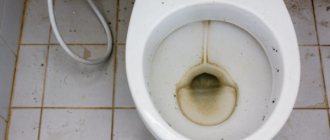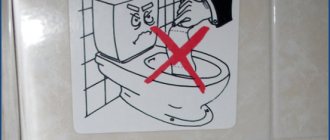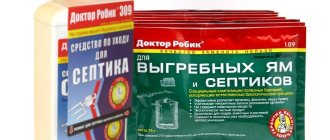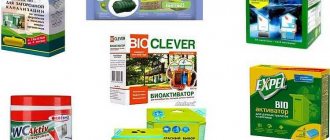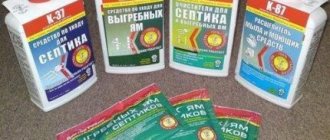Many modern wastewater treatment systems for private houses are organized on the basis of aerobic and anaerobic processing with the participation of bacteria.
At the same time, high-quality wastewater purification occurs under the influence of natural biological processes.
In order not to harm the home sewage system based on septic tanks, you should know exactly which washing powders can be used in this case and which cannot.
Content
- When should you clean your plumbing?
- What substances are dangerous for septic tanks
- Professional remedies for septic tanks
- Household (folk) remedies for septic tanks
- The right approach to washing plumbing fixtures
- Additional protection measures
In apartments and city houses, plumbing is connected to a centralized sewerage and wastewater system. In suburban residential buildings it is replaced by autonomous installations. The most common of them is a septic tank, which is a steel or plastic container for collecting wastewater. Inside the septic tank there is a filtration system with bacteria that accelerates the decomposition of microflora and disinfection of wastewater.
An alternative to such a system is a cesspool, the contents of which will have to be pumped out from time to time, hiring special equipment and people to service it. So a septic tank is generally more convenient and hygienic, but ordinary household chemicals that you are used to in a city apartment are not suitable for it. With wastewater it will penetrate into the tank and filtration unit and cause the following damage:
- Perforation of walls. Conventional detergents will corrode the walls of the septic tank, which will ultimately lead to their perforation and leakage. This is fraught with soil pollution, groundwater poisoning, death of plants and animals, and the formation of foci for the spread of infections, parasites and other harmful microbiota.
- Destroying bacteria. Microorganisms living in the filtration system of a septic tank process dangerous organic matter into safe ones. Conventional cleaning products are designed specifically to destroy “bacteria under the toilet rim” and will also destroy beneficial microbiota in the same way, destroying the entire filtration system.
As a result, the installation will cease to perform its function, and contaminated wastewater will begin to flow into the ground, poisoning groundwater and soil. Therefore, in a house where there is a septic tank, it is necessary to use special household chemicals that do not contain too aggressive substances. Let's talk about such drugs in more detail.
Mode of application
For any cleaning product to work effectively, you must follow certain requirements and rules:
Carefully study the instructions for use of the product, calculate the required amount of reagent suitable for a specific septic tank.
Provide yourself with personal protective equipment; their type is usually indicated in the instructions for the drug.
Hand protection Source septolit.ru
If the product has expired, it is not recommended to use it, since changes in the chemical composition may occur over time.
For the first use of the reagent, there are special formulations marked “for first use”.
When using ammonium salts, purified water must be removed from the site in a safe way; when using nitrates, purified water can be used to water plants.
It is not recommended to use nitrogen substances in autonomous metal sewers, since nitrates will settle on the walls of the system.
It is better to use a product for septic tanks with ammonium salts in a sewer system located at a distance of at least 20 meters from the house so that the fumes do not penetrate to the residential part of the site.
Metal septic tank Source kanalizaciya1.ru
When should you clean your plumbing?
baths. Sinks are the least dirty, bathtubs are the most dirty, and bidets, toilets and urinals are the most dirty. Therefore, plumbing care primarily concerns these products. The main reasons are the same as in a city apartment or house:
- Bad appearance. Over time, a coating forms on the surface of the product - substances from water, drained waste, and urine settle and form a sediment. It usually looks unpleasant, and the white color of the plumbing reinforces this by setting a contrast.
- Unpleasant smell. It may appear even before the formation of a full-fledged plaque. The characteristic odor is unpleasant in itself, in addition, it accompanies chemical processes and may also indicate bacterial activity.
- Harmful organisms. Urine and feces contain rich microbiota, and many of its species are causative agents of intestinal and other infections, for example, dysenteric amoeba causes dysentery. It is important to prevent the proliferation of microorganisms.
You will still have to clean the toilet and other plumbing fixtures, even if there is a septic tank, so you need to not only know the names of specific products - it is also important to understand the dangers of certain substances included in household chemicals. We'll talk about this later.
ADDITION
The transition from SMS household chemicals and from unnatural (i.e. ordinary - which are sold everywhere) hygiene products - to natural products at first looks as if not only there is no effect, but as if everything is getting even worse (both washing and washing hair and scalp itches). This is explained by the fact that, for example, in textiles that were previously washed with ordinary SMS powders, all sorts of chemical compounds have accumulated that cannot be rinsed out, and in hair that has been washed with ordinary chemical shampoo there are silicones and other chemicals, which also “do not let go” so easily. . Therefore, when switching to natural washing, you need to be patient. It’s better to rinse all the items a couple of extra times, clean out the old powder spots in the washing machine, and then endure a couple more washes with the new product until it can have direct access to the material that has already been cleared of chemicals.
What substances are dangerous for septic tanks
Any cleaning products must contain chemicals that destroy dirt. As a rule, these are potent active compounds: oxidizing agents, alkalis, strong acids. Their use may have a side effect in the form of damage to surfaces that have been cleaned with them. Therefore, it is very important to maintain a balance between the effectiveness and safety of drugs. When using a septic tank, the following substances are excluded:
- Chlorine and its compounds. Chlorine is a very strong oxidizing agent. It will simply destroy the filtering microbiota of your septic tank by reacting with the enzymes of microorganisms and destroying their physiological processes. Bleach (bleach or bleach) and many other chlorine compounds have the same effect.
- Phosphates. These are salts of phosphoric acid, quite strong. They have a high oxidizing effect and are not recommended even for ordinary sewerage. In the West they went out of circulation about 20 years ago. They are usually used with anionic surfactants, which creates a cumulative effect and increased danger.
- Phosphonates. These are esters of phosphonic acids that are part of many whitening products. They are also used in conjunction with surfactants, to which they impart a toxic effect. In addition, phosphonates settle in the sludge inside the septic tank and destroy the filter microbiota. It is better not to use them anywhere.
- Surfactants. Surfactants are a technical category of mineral and organic compounds with effects similar to chlorine. Depending on how they react, surfactants are classified as anionic, cationic, amphoteric and nonionic. They are gradually being withdrawn from circulation because they kill the microbiota of the filter.
Thus, cleaning products without chlorine, phenols and other aggressive petroleum products (organics), and strong bleaches are suitable for septic tanks. Such preparations are produced in the form of powders, concentrated solutions and liquid media, completely ready for use. There are professional and household products.
Reasons for using specialized products
Biological treatment stations compare favorably with conventional cesspools in a number of parameters:
- no unpleasant odor;
- waste products are completely recycled;
- there is no need to constantly clean sludge from the bottom of the tank;
- You can fertilize your garden plot with wastewater.
All these advantages became possible thanks to a special technology for processing fecal waste. Special bacteria are used to disinfect, neutralize and clean them. Inside the container, favorable conditions are created for their life and reproduction. Microorganisms “eat” waste and transform it into practically clean water.
The use of aggressive synthetic household chemicals leads to a decrease in the population of bacteria or their complete death. The installation process is disrupted. After this, it serves only as a storage tank. To prevent this from happening, you need to replace your usual hygiene products with environmentally friendly ones.
Professional remedies for septic tanks
Most preparations for cleaning plumbing available in the store contain the above substances. These compounds are relatively cheap to produce and therefore help maintain affordable prices for consumer products. A small amount of special branded preparations is suitable for septic tanks.
- ZERO. This is a remedy for Russian. It comes in the form of a gel and is suitable for all plumbing fixtures, from the toilet to the sink and even for tiles. Removes dirt, stains, fights dangerous bacteria, but does not harm the filtering microbiota of the septic tank. Biodegradable composition.
- MEINE LIEBE. The drug is from a famous German brand. It perfectly removes all types of deposits, from lime to urinary stone, destroys pathogenic biota and decomposes rust. At the same time, the product is safe for filter bacteria and is suitable for American-style toilets in which the bowl is filled with water.
- FROSCH. Another famous German brand owned by Werner & Mertz. Provides quick and high-quality removal of any plaque, lime deposits, and urinary stones. Safe for filter bacteria. The line offers many fragrance options, including mint flavors.
- ORGANIC PEOPLE. The brand belongs to the Russian company of the same name. The composition is based on natural pine oil, which provides disinfection and gives plumbing fixtures a pleasant aroma and freshness. Since there are no strong synthetics in the composition, the product is as safe as possible for plastic and filter bacteria.
In addition to these products, professional cleaning compounds Ecover and Chrisal (Belgian brands), AlmaWin and Sonett (German brands) are suitable for septic tank systems. They are less common on the Russian market than the first four names, but the quality is not inferior to the more popular ones.
On the other hand, if you have a septic tank, you cannot clean the plumbing with well-known, advertised products from the mass market. Eliminate brands such as Comet, Domestos, Cillit, and Toilet Duck. As a rule, these are cheap compositions, which can only contain the same cheap cleaning substances with a rough, aggressive effect.
Household (folk) remedies for septic tanks
If for some reason professional chlorine-free cleaning products are not available to you, household chemicals that can be easily found in most hardware stores and supermarkets are a good and septic tank-safe alternative.
- Table vinegar. This is an aqueous solution of acetic acid with a concentration of no more than 10%. It needs to be heated to 40 °C, applied to the plumbing overnight and left for 12 hours. Then simply rinse with water. Vinegar is good at removing plaque, urinary stones and eliminating unpleasant odors. Low concentrations do not harm filter bacteria.
- Lemon acid. You need two standard bags in which it is sold in all stores. Their contents should be scattered on a dry surface, rubbed and left in this form for half an hour, and then rinsed with water. The product removes odor and plaque well, and being very weak, does not harm the biota of the filter.
- Baking soda. Chemically it is sodium bicarbonate. It is suitable for the kitchen sink, where it will do an excellent job of removing grease deposits. Use both a concentrated solution and dry powder. The product is applied to the problem surface and left for two hours, and then washed off with water. Soda is safe for the biota of the septic tank.
In everyday life, some people also use Coca-Cola for cleaning plumbing fixtures. This method is less common than the previous ones, but is also quite effective. The drink should be poured onto the problem surface and left for five or six hours. Then simply rinse with water. Since Coca-Cola is intended for oral consumption, it is safe for biological systems in moderate volumes. At the same time, the drink removes plaque and urinary stones.
Unusual Products
Special attention should be paid to non-standard products, which can also eliminate blockages in pipes.
Drainwig system
The Drainwig system is a small technical device that helps eliminate the risk of blockages. The device consists of a flower-shaped mount and a chain up to 50 cm long. To install the system, you need to lower the chain into the bathroom or sink drain, and then fix the position of the device using the mount.
Thus, all small particles washed down the drain will cling to the chain, which will need to be pulled out periodically to get rid of debris. Such a system costs from 100 rubles.
Karcher
Karcher is a brand that produces machines for cleaning clogs. The advantages of such machines are:
- Instant removal of blockages;
- No harmful chemicals;
- Increased pipeline service life.
You can use the Karcher machine even in winter as a defrost, and with its help you can remove not only blockages in home drains, but also in the main sewer. The disadvantage, of course, is the high cost. However, this method is considered quite unusual.
There are also products available in tablet form, which are quite convenient.
The right approach to washing plumbing fixtures
Toilet bowl cleaners for septic tanks are gentler than regular household chemicals. To properly clean your plumbing, you need to be thorough. First of all, carefully study the composition of the drug and the recommended dosages, as well as the proportions of the components. All this is indicated on the label - read it, even if there is a mark on the container that the product can be used in homes with septic tanks.
Since the most contaminated plumbing fixture is the toilet, let’s look at the cleaning process using it as an example. There are three stages of caring for this product:
- Washing the inside of the bowl. You need to apply the composition; Even if the label says that it can be washed off immediately, it is better to leave it on for at least half an hour. This is especially important for biodegradable products, which are slower to act. Apply with a sponge or a special brush, paying special attention to the area under the rim - this is the main breeding ground for bacteria and the drainage area - urinary stone deposits form there.
- Washing outside. It is a big mistake to think that the outside of the bowl and tank can be washed by any means. They will still end up in the drain and in the septic tank, so you should still avoid conventional products and use the same solutions and powders that you used to wash the inside of the bowl. You can apply the composition with a brush or sponge, paying attention to the junction of the bowl and tank, the fastenings of the toilet seat and lid.
- Washing small parts. This is the final step that, contrary to what some homeowners may believe, should not be ignored. Using the same preparations, you need to go over the lid, toilet seat, and drain lever. Pay attention to the ribs on the inside of the lid and toilet seat - dirt always accumulates in such places, creating conditions for the active growth of bacteria.
The use of detergents that are safe for the septic tank is preferable even in its absence. A cesspool or central drainage system allows you to clean plumbing fixtures with cheap, aggressive preparations, but they can cause harm to the soil and groundwater, plants and animals, and the environment as a whole. Soft, especially biodegradable formulations are much safer and no less effective.
Classification of chemicals
The choice of product depends on the type of contamination.
The nature of the blockage in the bathroom, in the kitchen sink and in the toilet is different, so one drug may not be effective. Types of chemicals:
- Alkaline - powerful reagents for combating grease and soap scum. Sediments gradually linger on the inner walls of the pipes, forming dense build-ups and a sticky film that impede the normal drainage of water and the movement of large debris and food waste. Alkali completely corrodes plaque and slippery sediment.
- Acidic ones are the best means for cleaning sewer drains. To remove severe blockages, chemicals are used together with a mechanical method. The acidic solution breaks down debris in less contaminated areas, clearing the passage for plumbing cables.
Additional protection measures
In addition, a properly selected detergent alone is not enough to protect the septic tank from destruction. It is necessary to control all preparations used in household work, primarily washing powders and rinsing gels. In second place are compositions for dishwashers. For example:
- Powders and gel rinses from the brands Amway, BioMio, Frosch, Klar, and Synergetic are well suited for washing machines The last brand, by the way, is domestic; production is also located in Russia. Such compositions contain plant-based or biodegradable components that do not harm either the septic tank or the surrounding environment.
- Dishwasher safe. We recommend using solutions from brands such as Ecover, Oppo, Sodasan and some others. They also contain mild natural or synthetic but easily degradable compounds. This is important not only for the septic tank and soil, but also for your health: the gels are completely safe.
Harmless drugs have a different chemical composition and other external signs of a reaction. Therefore, at the beginning of their use, it may seem that they wash worse than usual products with aggressive components. This is actually not the case, but if you can't shake the thought, add a little more mild preparation. This will not make things worse, because the products are biologically safe and do not cause allergies.
Recommended Biodegradable Liquids and Powders
The list of brands that are used in the presence of VOCs includes:
- Pro-Bright and NNPTSTO: RF;
- Neutral: Denmark;
- Nissan: Japan;
- Ecover: Belgium
- Mini Risk: Finland.
In order not to harm the autonomous sewage system, it doesn’t hurt to take a closer look at the logos on laundry detergents:
- Eco flower. Assigned to high quality products in the EU.
- Falcon. Applied to Scandinavian products, which meets environmental standards.
- Blue Angel. It is used to mark German products that are safe for nature.
- Northern swan. The eco-label program has been operating in the Scandinavian countries since 1989. The sign was designed by Finnish artist Kösti Varis.
- Green Seal. The mark is found in the United States on cleaning and body care products.

